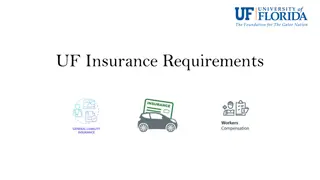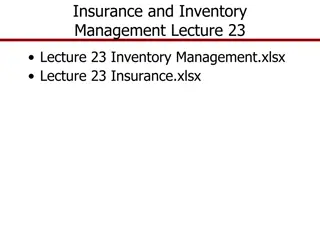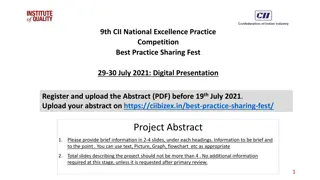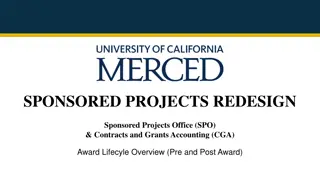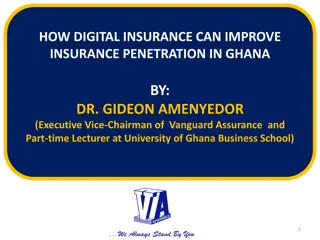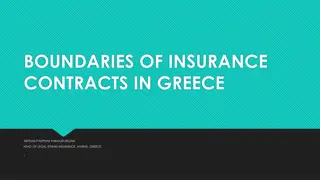CII Award in Insurance (W01) Course Overview
The CII Award in Insurance (W01) is a course aimed at insurance sector professionals, including those in HR, accounts, compliance, and other roles related to insurance. It covers topics such as risk management, insurance market, law of contract, and ethical standards. The course is suitable for individuals working in the financial services sector and is worth 15 credits towards the CERT CII Designation. It replaces the CII Insurance Legal and Regulatory (IF1) course and is essential for non-UK students studying CII exams.
Download Presentation

Please find below an Image/Link to download the presentation.
The content on the website is provided AS IS for your information and personal use only. It may not be sold, licensed, or shared on other websites without obtaining consent from the author. Download presentation by click this link. If you encounter any issues during the download, it is possible that the publisher has removed the file from their server.
E N D
Presentation Transcript
AWARD IN INSURANCE (W01) A CII, UK COURSE FOR NON-UK STUDENTS.
INTRODUCTION Award in Insurance (AWARD), which is examined and certified by the Chartered Insurance Institute (CII), London is aimed at delegates who mainly work in the insurance sector. The delegates do not necessarily need to be directly performing insurance duties, but the course extends to also include Human Resource employees, Accounts & Compliance staff, Research and Development employees, Health & Safety Officers and finally any other company employees whose roles include the association with or management of insurance contracts. Any person who is working in the financial services sector including new entrants who want to make a career in insurance plus estate agents responsible for the insurance division of the company, law firms and any other service companies who have interactions with the insurance industry via contracts. Finally, this module is a compulsory unit for students who are studying the CII exams outside the United Kingdom (UK). The unit offers 15 credits toward the CERT CII Designation and replaces the CII, Insurance Legal and Regulatory (IF1) course. Training Insurance professionals over the last 30 years
CONTENTS A. Risk and Insurance B. The Insurance Market C. The Law of Contract and Agency D. Insurable Interest E. Disclosure and Representation F. Proximate Cause G. Indemnity H. Contribution and Subrogation I. Insurance Regulation J. Ethical Standards, Corporate Governance and Internal control Training Insurance Professionals over the last 30 years
A A. . T The Nature and Main features of he Nature and Main features of R Risk and In isk and Insurance surance 1. The role of risk in insurance 2. Categories of risk 3. Features of insurance risks 4. Uninsurable risks 5. Components of risk 6. Insurance as a risk transfer mechanism 7. Why insurance is needed 8. Pooling of risks 9. Co-insurance 10. Self-insurance 11. Classes of Insurance Training Insurance Professionals over the last 30 years
a. a. T The Nature and Main features of he Nature and Main features of R Risk isk i. ii. iii. The risk management function and process The concept of risk and risk perception How different risks are categorized iv. The relationship between frequency and severity of loss v. The types of risks that can be insured and the type of risks that cannot. vi. What is meant by a peril and a hazard and the difference between the two as they relate to insurance. vii. How the fundamental principles of insurance are applied to scenarios. Training Insurance Professionals over the last 30 years
b b. . T The Nature and Main features of In he Nature and Main features of Insurance surance i. ii. iii. a. policyholders b. society in general iv. What is meant by: a. coinsurance b. dual insurance c. self insurance d. non-Insurance v. The main classes of insurance: a. long-term b. short-term The basis of insurance as a risk transfer mechanism How insurance operates by the pooling of risks How insurance benefits: Training Insurance Professionals over the last 30 years
B B. THE INSURANCE MARKET THE INSURANCE MARKET 1. The Structure of the Insurance Market 2. Insurers 3. Protection and Indemnity (P&I) Clubs 4. 5. 6. Lloyd s of London Intermediaries Distribution Channels 7. 8. 9. Price Comparison Websites Reinsurance Insurance Professionals Training Insurance Professionals over the last 30 years
a a. . T The Insurance Market he Insurance Market The way in which the market is structured on a: a. Global basis b. Regional basis. i. The main features of the different types of insurers. a. By ownership b. By function i. The unique structure and main features of Lloyd s ii. The main features and services of intermediaries in the insurance market iii. The different distribution channels used for the selling of insurance a. Direct channels b. Indirect channels iv. The basic purpose of reinsurance. Training Insurance Professionals over the last 30 years
b. b. T The Insurance Profession he Insurance Profession i. The main functions of underwriters ii. The main functions of claims personnel iii. The main functions of loss adjusters and loss assessors iv. The main function of actuaries v. The main functions of risk managers vi. The main functions of compliance officers vii. The main functions of the Chartered Insurance Institute (CII). Training Insurance Professionals over the last 30 years
C. The Law of Contracts and Agency C. The Law of Contracts and Agency 1. Essentials of a valid contract 2. Intention to create legal relations 3. Capacity to Contract 4. Offer and Acceptance i. Postal Acceptance 5. Consideration 6. Cancellation of Insurance Contracts 7. Agency 8. Insurer / Intermediary best practice Training Insurance professionals over the last 30 years
C. The Law of Contracts and Agency contd C. The Law of Contracts and Agency cont d Contracts: i. The essentials of a valid contract of insurance ii. How contracts of insurance can be terminated Agency : i. The methods of creating and agent / principal relationship ii. The duties of an agent to his principal and the duties of a principal to his agent. iii. The consequence of an agent s action on his principal. iv. Suggested content of business agreements or best practice between an insurance and an intermediary. Insurable Interest: i. The requirements for insurable interest in insurance contracts Training Insurance Professionals over the last 30 years
C. The Law of Contracts and Agency contd C. The Law of Contracts and Agency cont d Indemnity: i. The definition of indemnity and which types of policy are policies of indemnity ii. How the indemnity principle is applied to contracts of insurance iii. What is meant by agreed valued, new for old, reinstatement and first loss policies iv. How average is applied to non-complex cases of insurance Contribution: i. The principle of contribution and when and how it applies to the sharing of claims payment between insurers in straight forward property cases. ii. The common law principle of contribution iii. The policy condition meaning of contribution Subrogation: i. The principle of subrogation and why it may or may not be perused in simple circumstances ii. The common law principle of subrogation iii. The policy condition meaning of subrogation Training Insurance Professionals over the last 30 years
C. The Law of Contracts and Agency contd C. The Law of Contracts and Agency cont d Disclosure and representation: i. How the principles of disclosure and representation apply to contracts of insurance ii. How the duties relating to disclosure and representation operate in insurance contracts, how it is modified by policy wordings and the contrast with life assurance contracts. iii. Legal definitions relating to disclosure and representation and factors that might limit their entitlement to information. iv. The consequences of non-disclosure or mis-representation of the relevant information. Proximate cause: i. The definition of proximate cause and how it is applied to non-complex claims ii. Insured perils / excluded or excepted perils / uninsured perils or unnamed perils iii. Modification of the principle of proximate cause by policy wordings iv. Smoke , Water damage or blowing up of neighboring buildings also deemed fire loss. Training Insurance Professionals over the last 30 years
D. Insurable Interest 1. 2. a. Life Insurance b. Marine Insurance c. All other General Insurance 3. Creation of Insurable Interest: a. Ownership b. Joint Owners c. Contract d. Statute e. Bailees 4. Application of Insurable Interest to different scenarios Definition of Insurable Interest as a fundamental principle of insurance Timing of Insurable Interest for different classes of insurance: Training Insurance professionals over the last 30 years
E. Disclosure and Representation 1. Principle of Good Faith previously Utmost Good Faith 2. Duty of Disclosure: i. Before contract formation ii. During Policy Period iii. At renewal 1. Relevant Information 2. Consequences of Non-Disclosure and Misrepresentation: i. Marine in Act 1906 ii. CIDRA 2012 iii. Insurance Act 2015 1. Compulsory Insurance: a. 5 Classes in the UK. Training Insurance professionals over the last 30 years
F. Proximate Cause 1. Meaning of Proximate Cause: i. Meaning defined by - Pawsey v Scottish union and National (1908) ii. First Cause iii. Dominant Cause 2. Insured Perils: i. Fire ii. Lightning iii. Explosion (domestic) 3. Excepted or Excluded Perils 4. Uninsured or Unnamed Perils 5. Modification by insurance policy wordings i. Directly or indirectly ii. Remotely iii. Whether war be declared or not Training Insurance professionals over the last 30 years
G. INDEMNITY 1. Definition of Indemnity i. A fundamental insurance principle ii. An exact financial compensation iii. Benefit Policies 1. Application of Indemnity 2. Measuring Indemnity 3. Modifying Indemnity 4. Limiting Factors Training Insurance professionals over the last 30 years
H. Contribution & Subrogation 1. i. Definition ii. Common law position iii. Policy position 2. Application of Contribution 3. Subrogation: i. Definition ii. Common law position iii. Policy position 4. Insurer s Subrogation Rights i. Ex-gratia payments 5. Insurer s rights concerning Subject Matter 6. Precluded Subrogation rights i. Subrogation waiver ii. Hold Harmless Clause Contribution: Training Insurance professionals over the last 30 years
I. INSURANCE REGULATION I. INSURANCE REGULATION 1. Role of the Insurance Regulator 2. International Association of Insurance Supervisors (IAIS) i. Executive committees ii. International Templates iii. Group of 20 Countries 3. Capital adequacy of Insurers i. MCR ii. SCR iii. Solvency I iv. Solvency II 4. Combating financial crime 5. Fraud Training Insurance professionals over the last 30 years
I. INSURANCE REGULATION I. INSURANCE REGULATION Role of the regulator: i. The role of the regulator in the insurance industry. ii. The international standard setting body for the insurance industry, the IAIS. iii. The international standard setting body in relation to financial crime, the FATF iv. The different type of regulatory approaches (including principles-based, risk-based and prescriptive based regulation v. Prudential and market conduct regulation. vi. Tools used by regulators to supervise the industry. Capital adequacy: i. The importance of establishing and maintaining capital adequacy. ii. The different approaches to capital adequacy. iii. The relationship between capital adequacy and solvency control levels. Training Insurance professionals over the last 30 years
I. INSURANCE REGULATION I. INSURANCE REGULATION Anti money laundering and counter terrorism financing: i. The regional and global problem. ii. The FATR definition of money laundering iii. Know your client, the main principles. Fraud: i. The different types of fraud faced by insurers. ii. Fraud management by the insurer. Training Insurance professionals over the last 30 years
J J. . Ethical Standards, Corporate Governance and internal control Ethical Standards, Corporate Governance and internal control 1. 2. 3. i. GDPR ii. Consumer Rights Act 2015 Fit and Proper Requirements Internal Control System Data Protection Act 1998 Training Insurance professionals over the last 30 years
J. J.Ethical Standards, Corporate Governance and internal control Ethical Standards, Corporate Governance and internal control Ethical Standard: i. The scope and operation of the CII ethical code of practice in broad outline. ii. The expectation of customers, the public and regulators that customers will be treated fairly. Suitability: i. The objectives of fit and proper and the risks of unsuitability. Internal Control System: i. Risk management framework outlined. ii. The role of compliance and audit iii. Establishing a customer complaints procedure. Training Insurance professionals over the last 30 years
THANK YOU FOR PURCHASING THIS COURSE The SBN Training Team: +44(0) 751 004 0515, +592 659 1689, +1 868 349 2491 Email: training@sbnhumancapital.com Web: www.sbnhumancapital.com LinkedIn: sbnhumancapital Facebook: sbnhumancapital Instagram: Sbn_humancapital YouTube: Insurance Education - @insuranceeducation8950 Training Insurance professionals over the last 30 years












